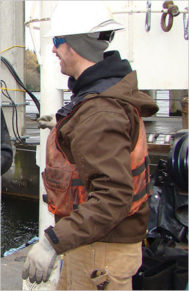Stay warm when working in the cold

Extremely cold weather can be dangerous for outdoor workers and those who work in an area that is poorly insulated or without a heat source. Two dangerous health risks associated with cold weather are hypothermia and frostbite.
Hypothermia
According to the Centers for Disease Control and Prevention, when exposed to cold temperatures, the body starts to lose heat faster than it can produce it. If this happens for a prolonged period of time, the cold eventually will use up all of the body’s energy, resulting in hypothermia, or an abnormally low body temperature. Symptoms vary from person to person, but early signs of hypothermia include shivering, fatigue and confusion. More advanced symptoms include blue skin, dilated pupils and loss of consciousness.
From the "First Aid" course offered by the National Safety Council. Learn more about NSC first aid and CPR training – including online and classroom training for learners, and courses and materials for instructors. © 2015 National Safety Council
If you suspect a co-worker is suffering from hypothermia, CDC recommends taking the following steps:
- Alert the supervisor and request medical assistance.
- Move the victim into a warm room or shelter and remove any wet clothing.
- Warm the center of the victim’s body first – chest, neck, head and groin – using an electric blanket, if available. Otherwise, use skin-to-skin contact under loose, dry layers of blankets, clothing, towels or sheets.
- If the victim has no pulse, begin CPR.
Frostbite
Frostbite causes a loss of feeling and color in the affected area – most often the nose, ears, cheeks, chin, fingers or toes, CDC notes. It can permanently damage body tissue and even lead to amputation in severe cases. Symptoms include numbness and tingling, reduced blood flow to the hands and feet, aches, and pale or waxy skin.
Workers suffering from frostbite should:
- Find warmth as soon as possible.
- Refrain from walking on frostbitten feet, as this can increase damage.
- Immerse the affected area in warm – not hot – water.
- Avoid rubbing or massaging the frostbitten area.
- Avoid using a fireplace or radiator for warmth. Affected areas are numb and can be easily burned.
When working in cold temperatures cannot be avoided, CDC recommends the following:
- Wear layers of loose clothing and avoid tight clothing, as it can restrict blood circulation.
- Ensure the ears, face, hands and feet are properly covered.
- Wear waterproof and insulated boots.
- Move into warm locations during breaks.
- Include a thermometer and chemical hot packs in your first aid kit.
Workers should watch out for one another. Monitor your physical condition as well as your co-workers’.

